Lit up! Night transformations of Lakhta Center
In one gray-gray city there was a dark-dark tower ...

They say that before it was building, and then - finishing work. People worked in three shifts, and at night it was like a beacon of light. And then the complex was inhabited by the inhabitants of the offices. Every day, who earlier, who later, they went home, one after another dimmed the light ... Lakhta Center gradually plunged into darkness, and it appeared - the Tower of Darkness ...
')

How do you like such a horror story? What really will happen to Lakhta Center at nightfall - read under the cut.
Light in darkness is the friend of all living things.
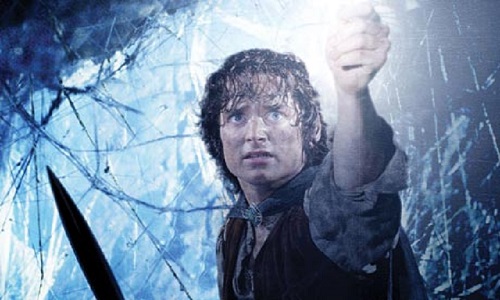
All creatures are drawn to him - from moths, driven only by instincts, to wandering travelers, rejoicing in salvation. In the dark sky, we are looking for stars, in a dark nook - the nearest lantern. We are warmed by the light in our own window, and we treat winter blues with festivals of lights in the open spaces from London to Moscow.
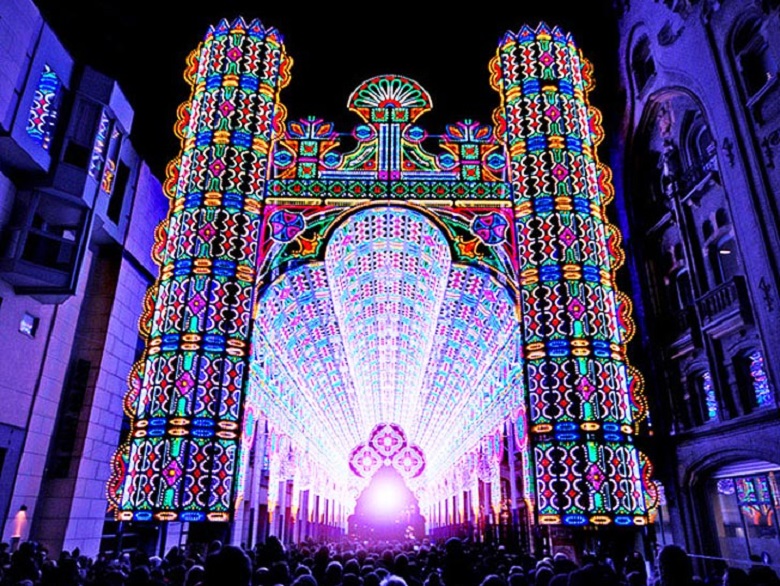
Festival of Light in Belgium. Photo source
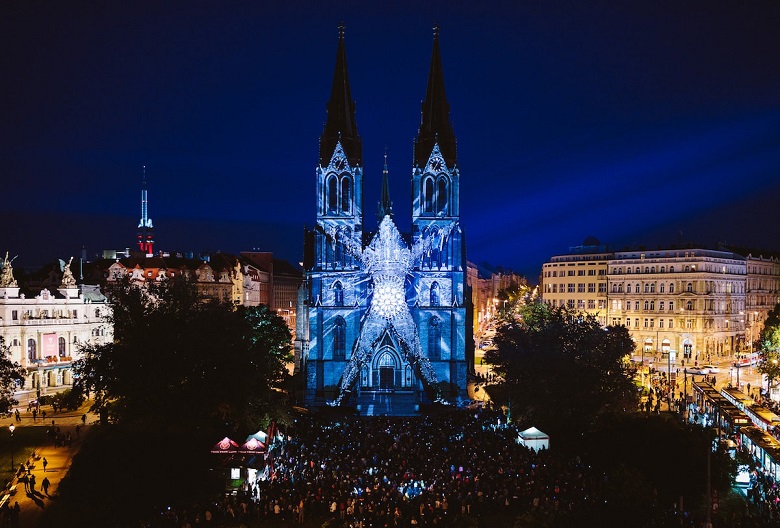
And Prague ... Photo source
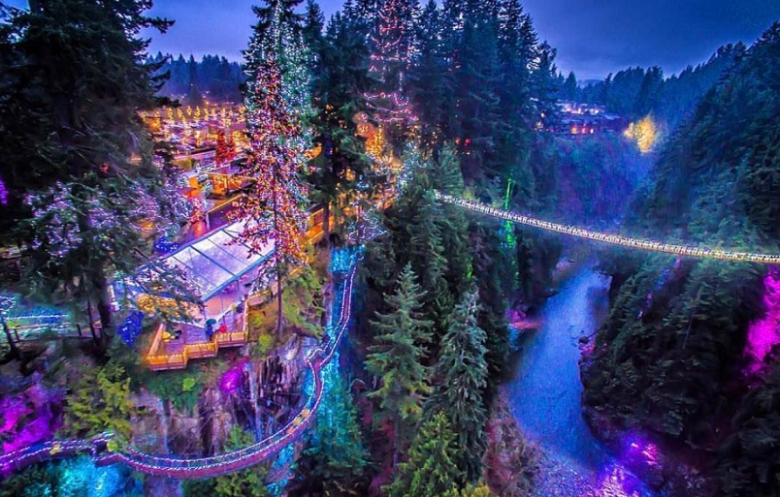
Winter Canyon in Vancouver. Photo source
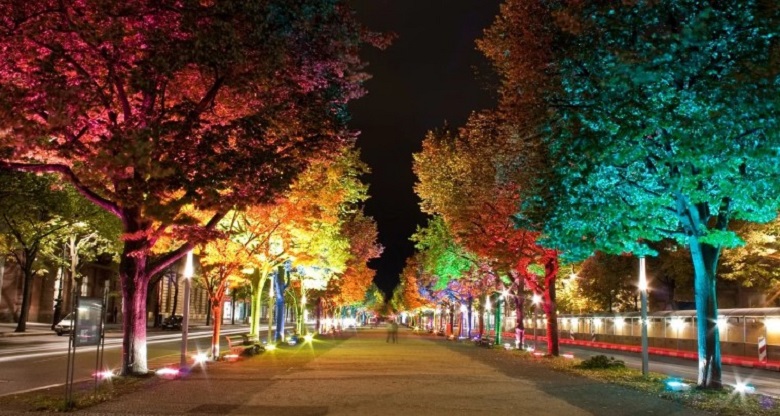
And linden alley in Berlin
We turned night cities into a kingdom of light and no longer sleep at night - a man-made shine breaks a thousand-year rhythm. Life no longer has to stop with the advent of darkness. Night city is beautiful and sometimes unrecognizable.

Lomonosov Bridge over Fontanka, Petersburg
City buildings at dusk begin to transform. By midnight, some change shape, others - coloring, the third almost disappear, the fourth come into "movement." Not so long ago, the utilitarian night illumination today is turning into a light architecture, creating new spaces and a new quality of environment. These are the trends.
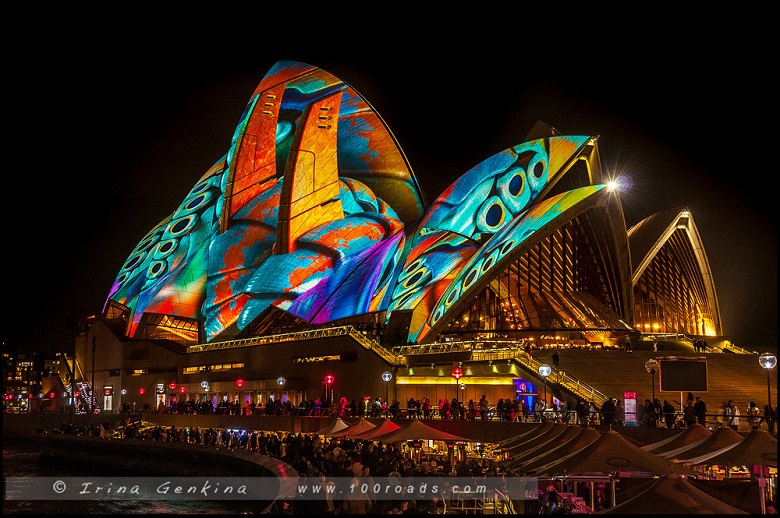
Sydney Opera. Photo source
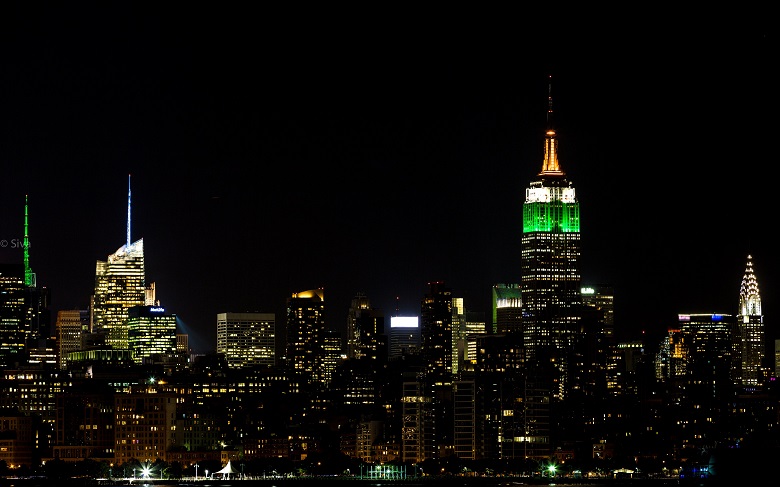
Empire State Building and the panorama of the night in New York. Photo source
We couldn’t pass by this new shining reality, entrusting Lakhta Center's illumination to the moon, stars and earned office dwellers. Our designers got down to business. Let's see what they did?
The question of the visibility of the tower almost headed the agenda of the Lakhta Center in 2011. It seemed even less important how to build this uniquely complex object - it can be solved. But a heightened sense of visibility required a carefully weighted approach.
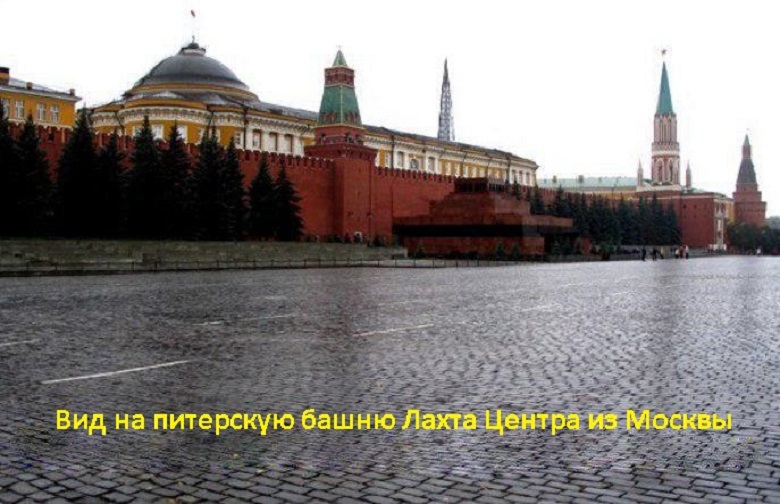
The architectural history begins with the visualization of remarkable panoramas taking into account the appearance of a new dominant on the Petersburg horizon.
Daria Gerasimova, Chief Specialist-Designer of the Design Office of Lakhta Center:
As a result, the research has turned out such visualizations of panoramas:




Panoramas on the site of Lakhta Center
Of course, the tower can be found here - with its height it is strangely different. But somehow you can’t call the supertoll noticeably changing the panorama of the center - it is lost sight of due to the distance and features of the facade. Glass absorbs the colors of the sky and dissolves in the air, leaving only a hint and vague outlines - you need to know where to look. Today it is possible to compare visualization with the real picture.

Photo source

Photo source

Photo source
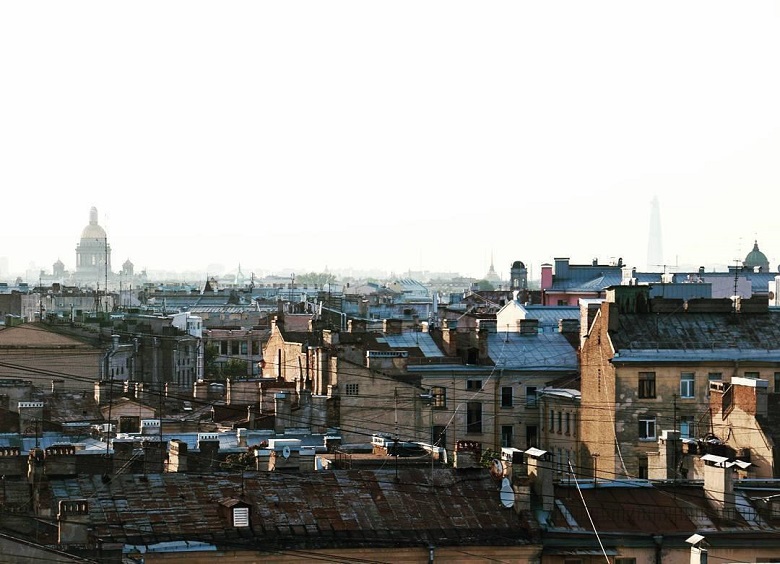
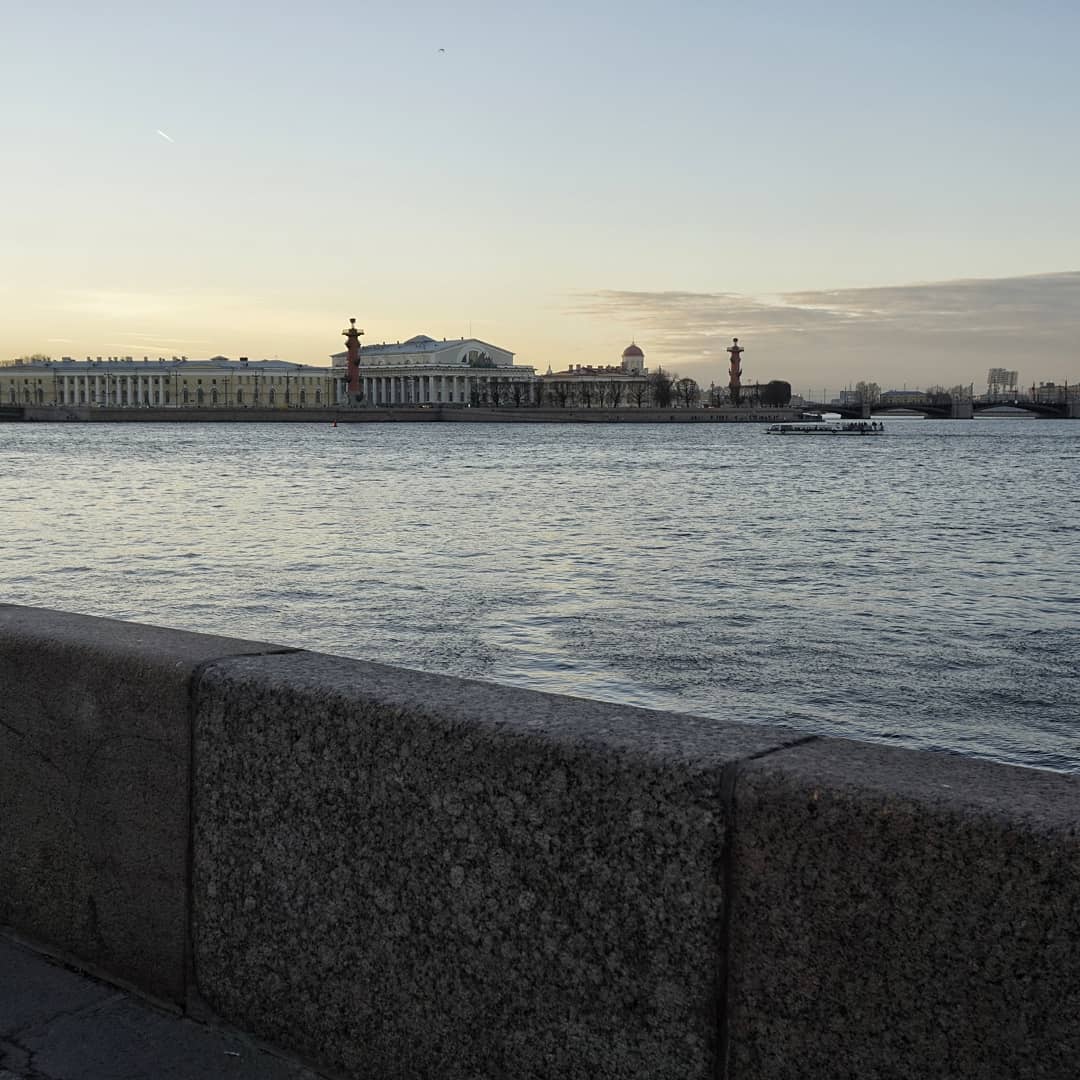
Photo source
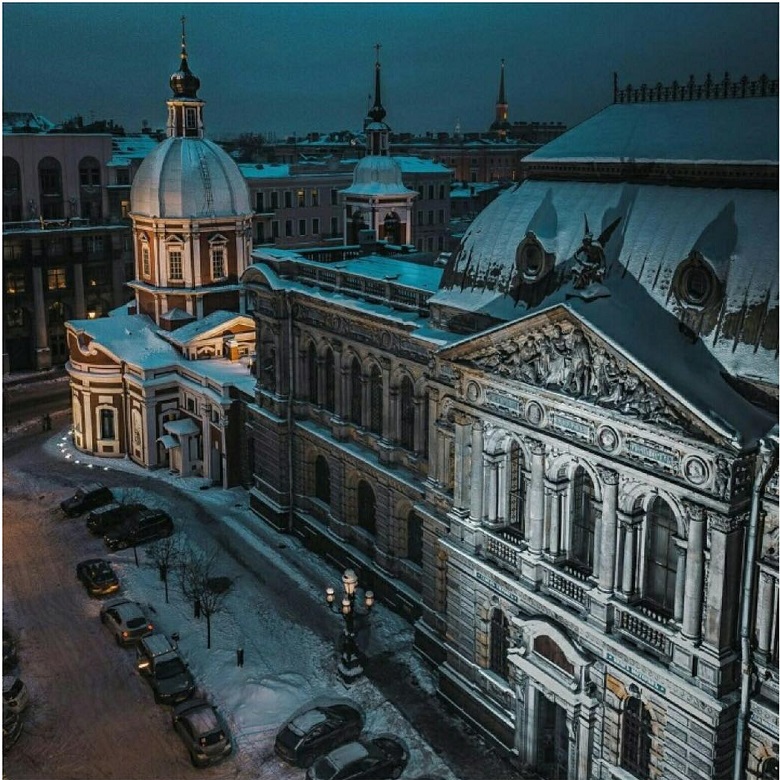
Photo source
The distance, the facades and the weather do their job - the new and old city lives peacefully and practically isolated - the triumph of architectural segregation.
But it is afternoon. What happens at night? Darkness calls for antagonism. The meaning of the illumination is opposite to the daily tasks - we must not get lost in the darkness, stay on the horizon, get out of the dusk, become visible ...
The possibilities of Lakhta Center in this matter are measured in kilometers of LED strips, thousands of facade lights, 16 million light shades of the full color spectrum.
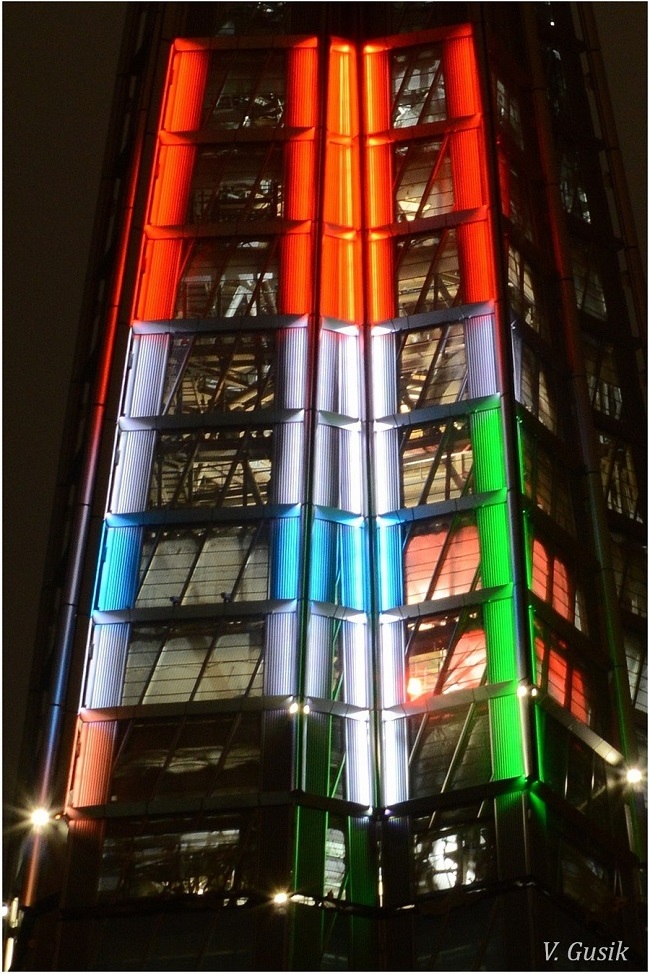
Testing backlight on the tower Lakhta Center. Photo by Victor Gusik
If you ignite in full - will be Las Vegas.
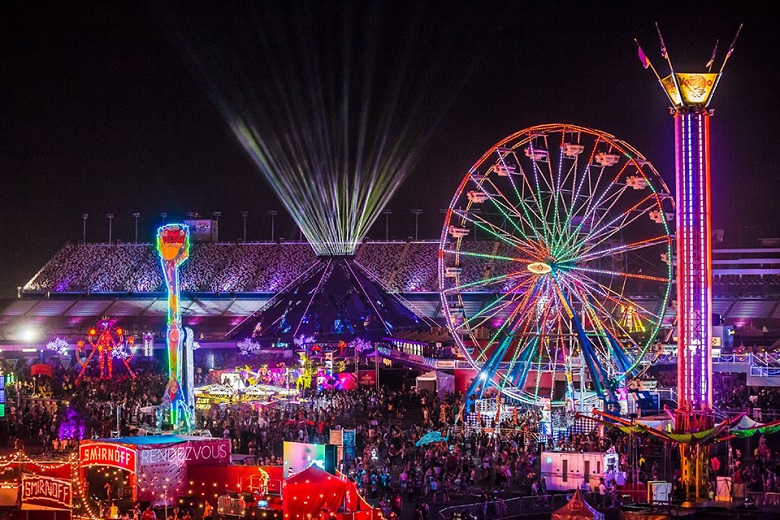
How light opportunities will be used is determined by the concept of architectural lighting. It was created jointly by engineers and designers of the Lakhta Center and specialists from Lichtvision Design & Engineering. To find out if light expansion is envisaged, take a look at the document.
In fact, the “team of light” was to build a second facade of the complex, layering the light envelope on top of constructive forms. Today, experts implement different ideas - they can completely change the night look of a building, from color to proportions. But in our case it was about recreating the day view of the Lakhta Center in the night reality.
The basis of the architectural concept of the complex is images of water: waves, hummocks, cracked icebergs ... And all this is cold, local, referring to the shores of the Baltic, to the northernmost of the skyscraper coordinates.
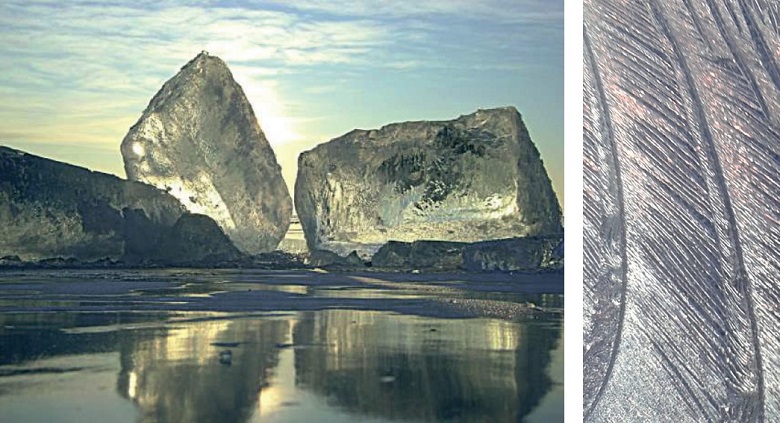

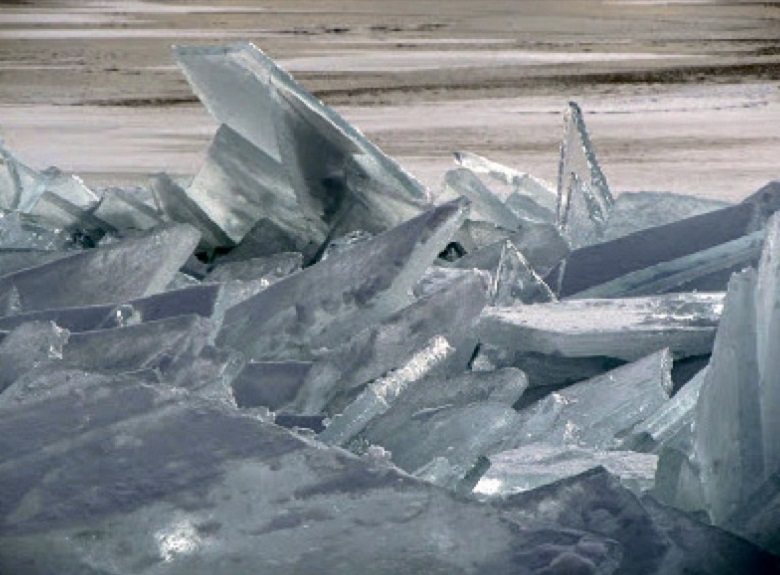
Illustrations from the concept of architectural lighting Lakhta Center
From here, themed natural images turn into the concept of illumination: pure ice, illuminated by the sun, soft light flickering in the waves, cool blue, natural white. This outlines the color gamut, the intensity of the shades and the dynamic effects of the backlight.
The daily temperature of illumination ranges from 3 to 4 thousand kelvins. It is a natural white color, soft and pleasant to the eye. This happens at sunrise, still gentle and cool.
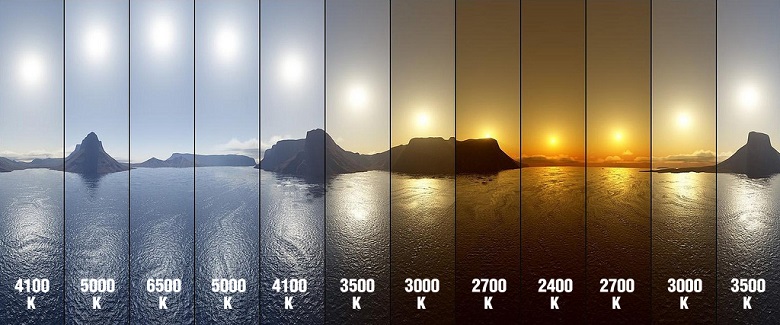
Photo source
Warmer - a landscape with three thousand Kelvin, colder - the roof of the atrium with four. In the middle of the scale are the facades of the Multifunctional building and the tower: their luminescence heats up to 3, 5 thousand kelvins.
The intensity of the backlight is also regulated. The brightest light is provided for entrances, stairs, walkways, ramps - average values vary from 10 to 20 lux (lumens per m2). Here, the designers did not invent anything, taking the European and Russian norms as the basis. Those, in turn, appeal to the rational - a sense of security, adaptation, orientation and comfortable movement.
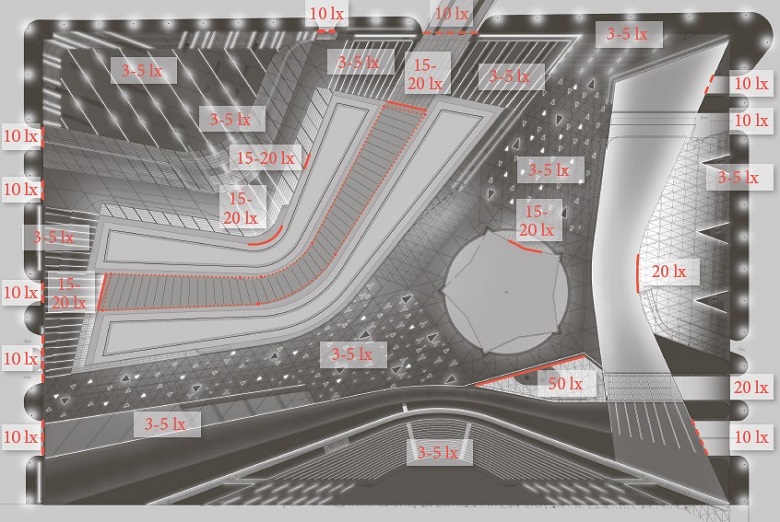
Illustration of the concept of architectural lighting Lakhta Center
The facades of the tower in everyday mode are illuminated at the level of the same 15-20 suites. Such intensity can be compared with the light of St. Petersburg twilight. 20 suites is about the intensity of natural light these days at the beginning of the ninth.
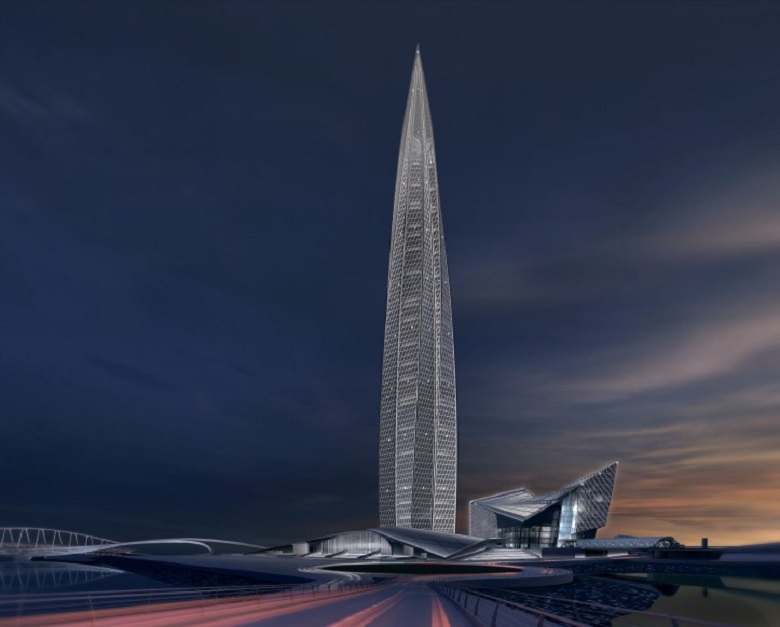
General view of the complex at night, taking into account the lighting intensity scheme. Illustration of the concept of architectural lighting.
Julia Gulyak, Head of the Design Office of Lakhta Center:
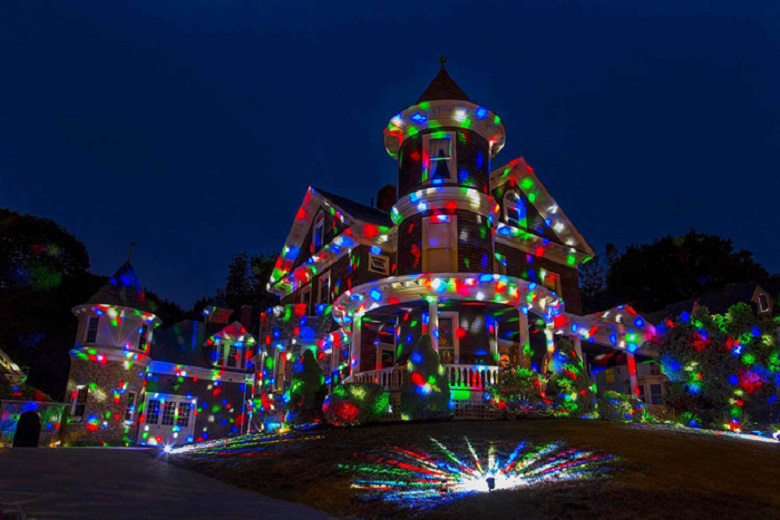
Not our option. Photo source
Descriptions of light restraint and subtle light hints are found throughout the text of the concept: “The goal is to create an elegant, sophisticated image, a memorable building, a symbol of grace, calm and restraint,” the designers fix the basics. And turn for this to an interesting reception.
The architectural appearance of the tower is formed by 15 faces, going upwards and meeting at one point.
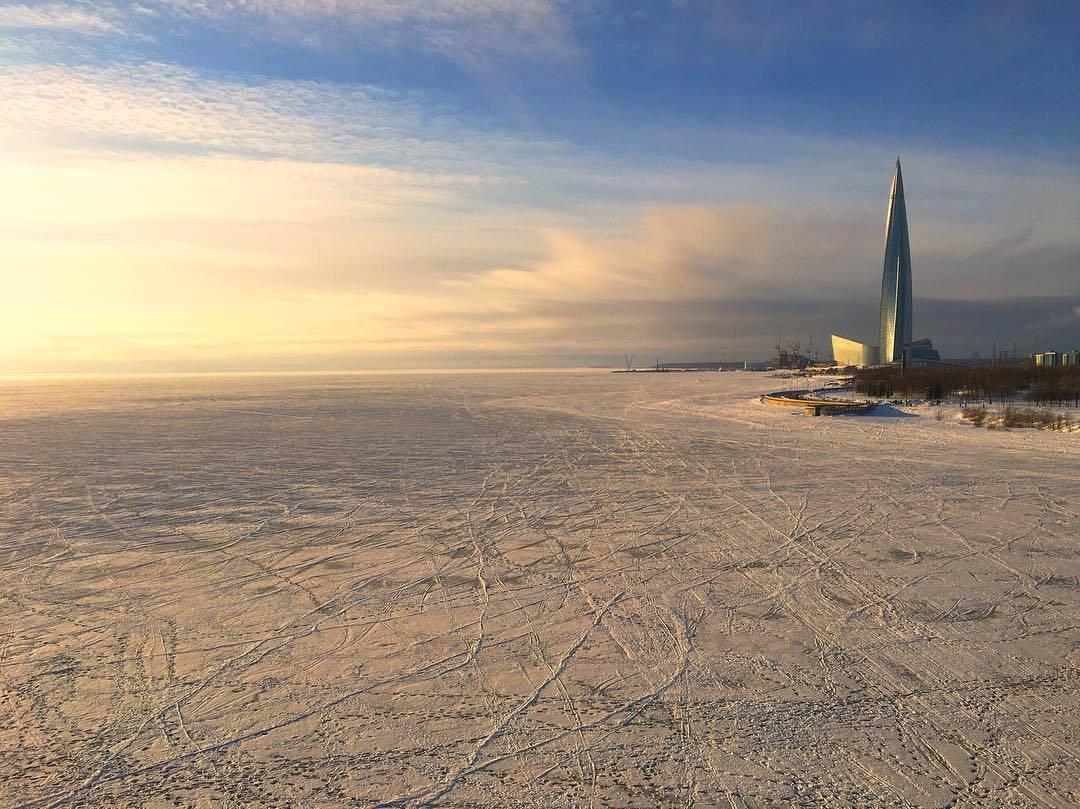
Photo source
It is difficult to refrain from emphasizing precisely these dynamic lines with light. But the paths of least resistance usually lead the wrong way. Here and a sharp contour lighting led away from the desired restraint and subtle Petersburg flavor.
Julia Gulyak:
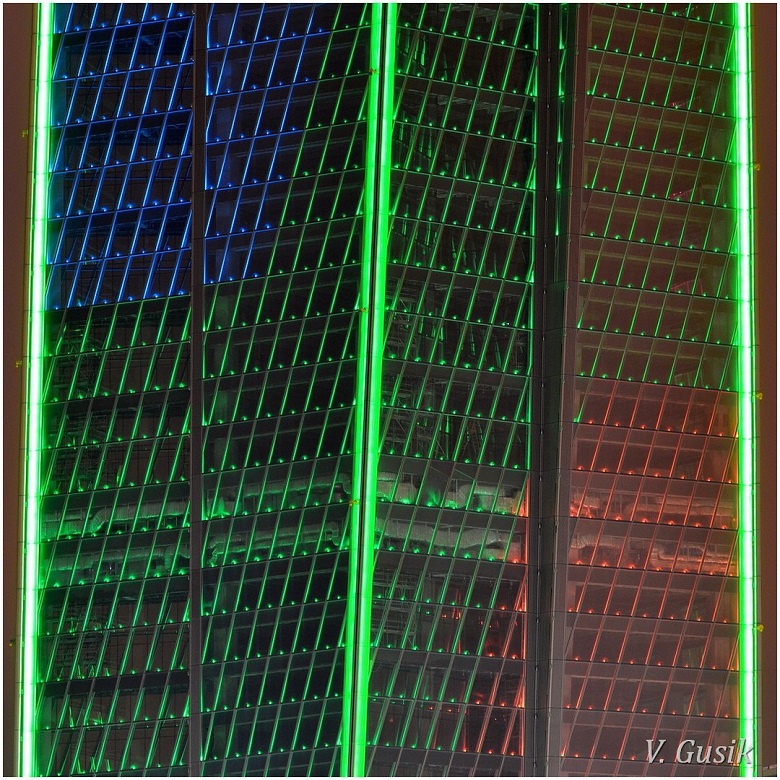
“Pixel” illumination of the facade of the tower - on the example of a fragment of New Year's illumination. Photo by Victor Gusik
Scattered light is applied to all objects of the complex, including landscape lamps. Bright ends, clear contours, contrasting combinations, play of light and shadow turned out to be forbidden - on the same faces it was replaced by a gradient. Good? Yes, not really.
There is an organization in the city that requires the tower to be seen very clearly. Thin and delicate light hints sent by a skyscraper into the darkness of St. Petersburg are inappropriate for it. Because for the “Rosaviation” the designation of the boundaries of the object on the ground must be unambiguous.
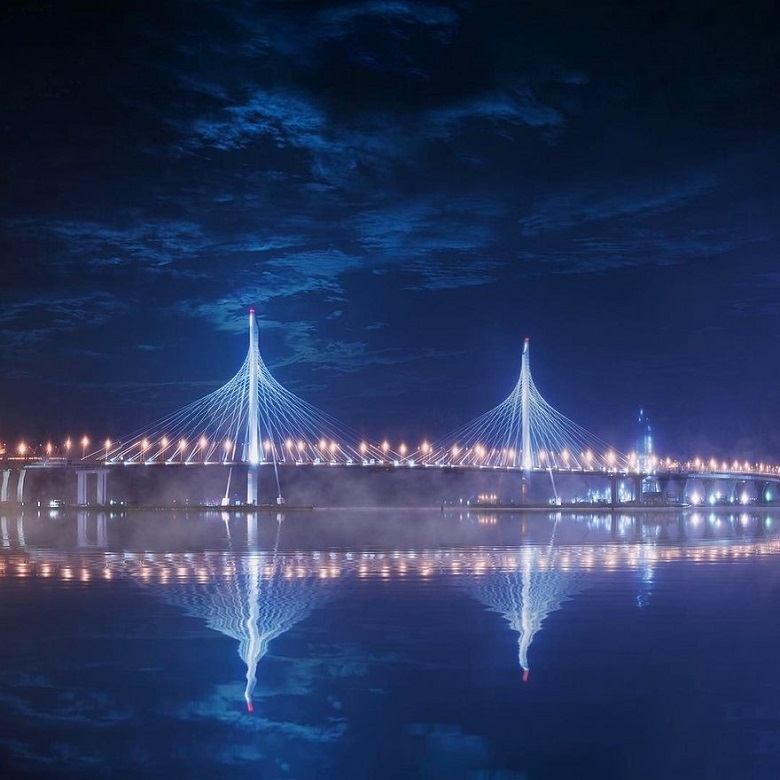
Barrier lights on the WHSD cables. Photo source
Red barrage lights on high-rises, antennas, guys St. Petersburg bridges and guys stadium St. Petersburg you saw. This is an international light-marking system, exactly the same red lights, for example, on the hero of the week before last — the New York legend sold by the Chrysler Building.

Taking into account the height of the Lakhta Center tower, red beacons would have to be located almost throughout the whole volume. Knowing the designers, it is easy to imagine how they would worry about alien inclusions of lights of a non-complementary shade.
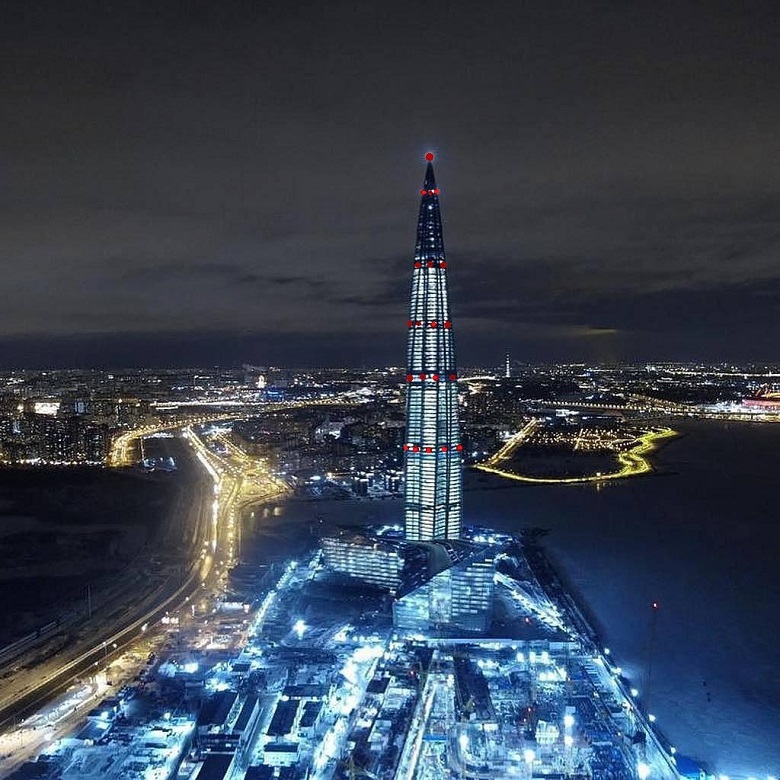
It is better for them not to show ...
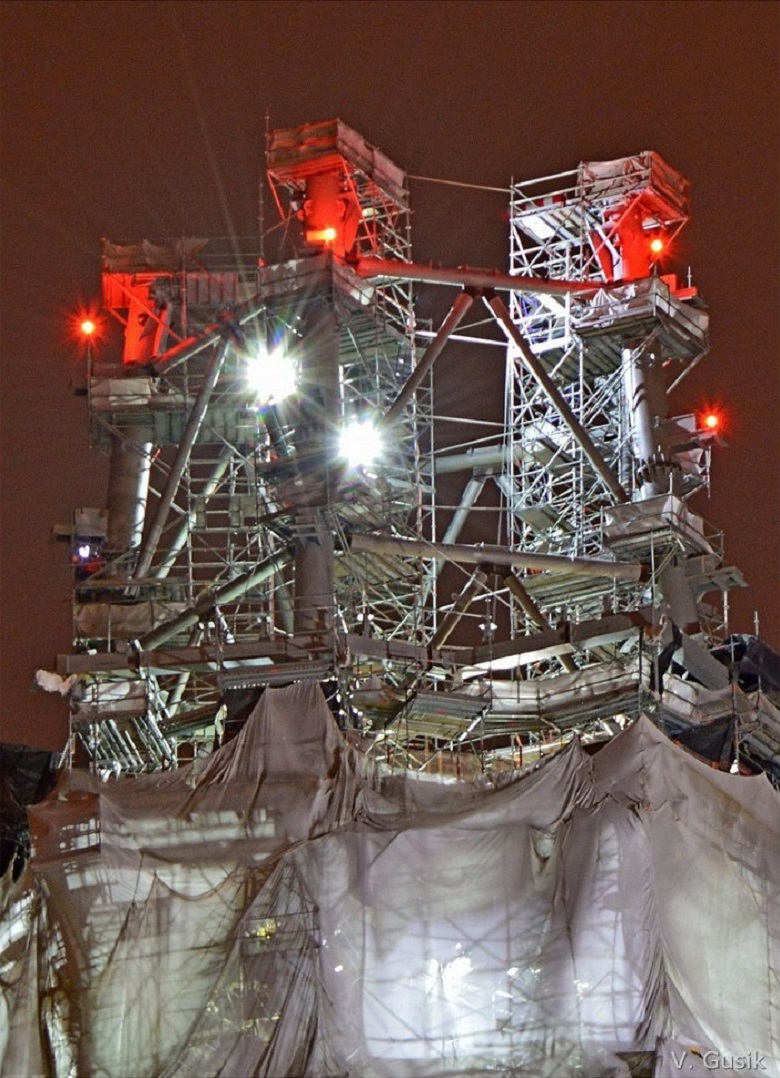
During construction, the barrier light was standard - red and a bit intimidating. Photo source
Fortunately, according to the Guidelines for the Operation of Civilian Aerodromes of the Russian Federation (REGA RF-94), for buildings located outside the airfield, the fire can be not only red, but also blinking white. “The intensity of light in all directions should not be less than 10 cd, the frequency of flashes should be at least 60 per minute. The height should be 45 m. ”
Based on the found rate, we developed a variant of the barrier lighting for the tower. Now every 45 meters she has - white LED lights, ten per floor, plus a beacon on the steeple. And the “Rosaviation” is good, and it fits perfectly into the overall concept of the backlight.
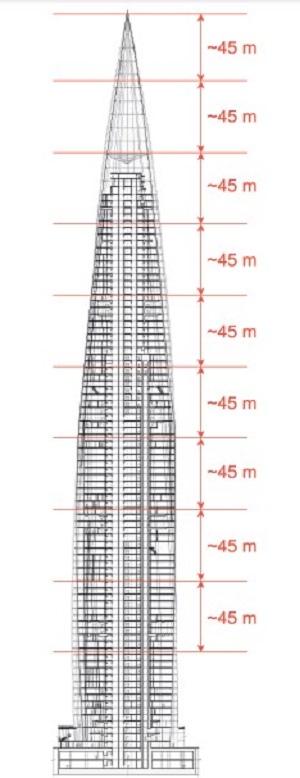

Layout of barrier lights on the tower. Illustration of the concept of architectural lighting Lakhta Center
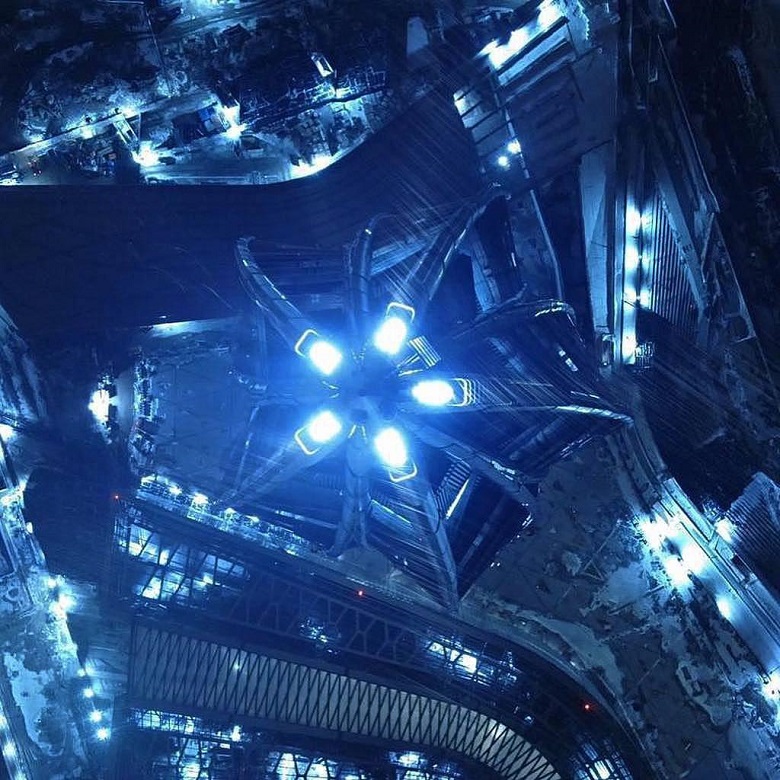
White barrage lights on the tower spire. Photo source
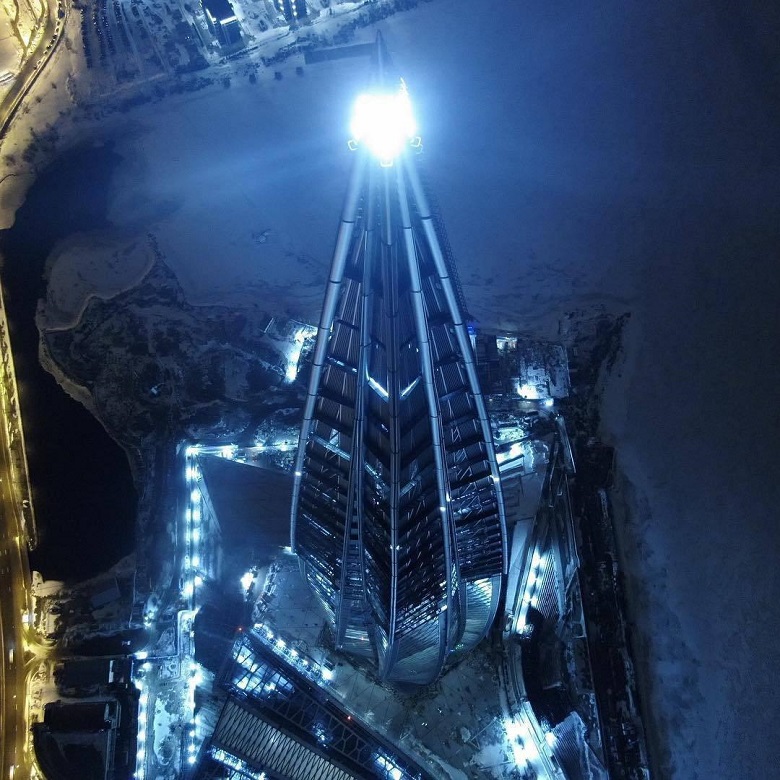
Lighthouse on the steeple. Photo source
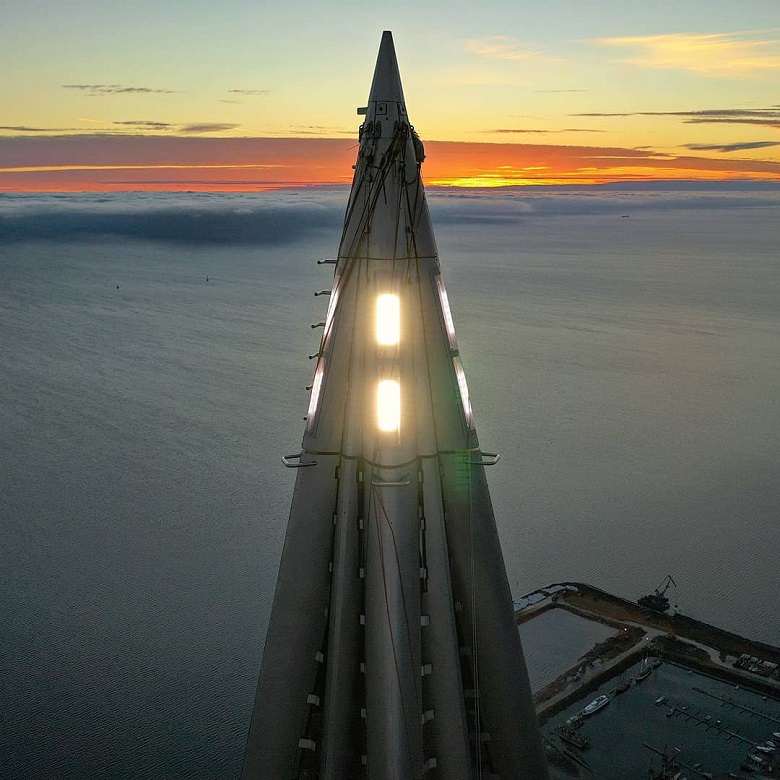
Barriers include not only at night, but also at any time of the day while reducing visibility. Photo source
The “white” fence is innovative - the project was separately coordinated with the regulatory authorities.
And voluntarily passed another agreement - from the unusual.
If the words “bird rights” cause you some confusion, it means that you are definitely not a resident of Canada or, for example, America. Perhaps we have few skyscrapers, a lot of birds, and there is still something to work in the legal field on other issues, but the experience of Lakhta Center in the field of protection of birds can be considered unique for domestic practice.

Photo by Victor Gusik
We have already told how ornithologists conducted bird watching in Lahta. For the concept of architectural lighting, scientists also gave their recommendations. The greatest curtsy in the direction of the birds is a change in the lighting regime during the period of seasonal migrations. Since the birds fly at night, in the fall and spring from 2 at night and until 9 in the morning the lighting will be minimal so as not to attract flocks to the light trap. Perhaps this is the only moment that could cause mutual misunderstanding and lead to unpleasant accidents.
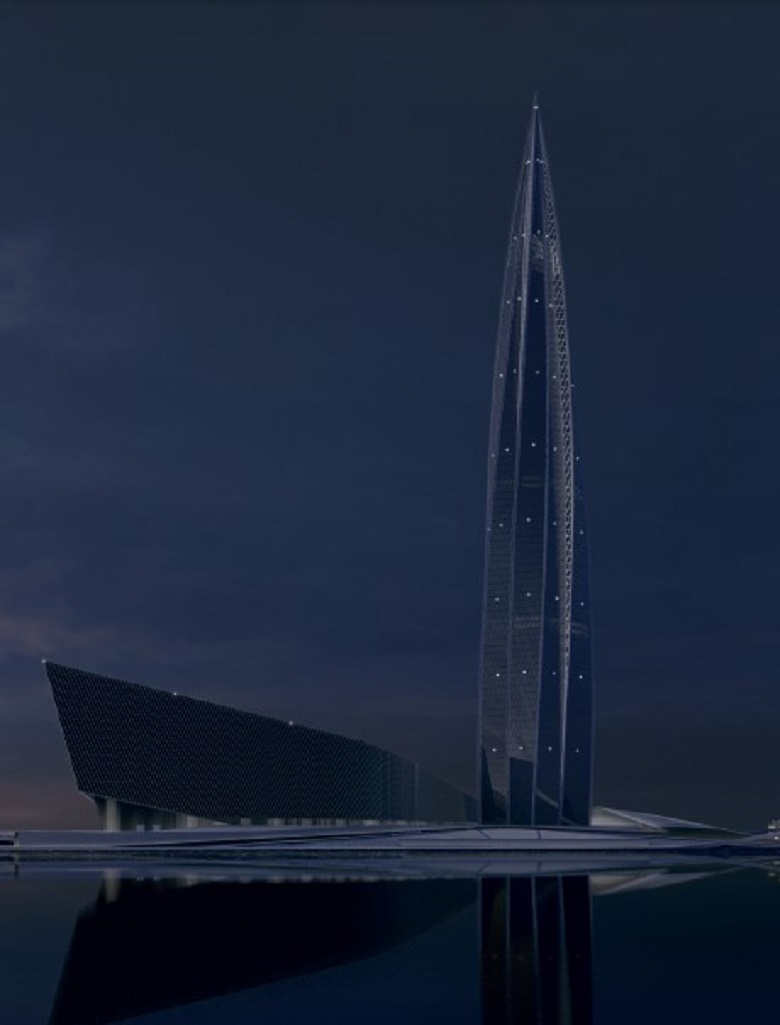
The most minimalistic - backlight mode. Barrage lights for aircraft and light on the front faces of the facade are involved.
By the way - in the States ornithologists are statistics of air incidents involving birds. According to the relevant federal agency US Fish & Wildlife service, less than 1% of birds die from collisions with skyscrapers, about 56% of the incident occur to low-rise buildings, and about 44% in general in rural areas. This is consistent with the data of our ornithologists - they also noted that the main stream of birds goes at elevations up to 100 meters.

Photo by Ivan Smelov
Also in the reports they dispel the main myth - that the birds do not distinguish glass as a barrier. Glass birds see as a barrier to distinguish, from the collisions go. So the most difficult issue with a glass facade is another.
Placing a lamp on a brick wall is not difficult.

Photo source
On a transparent glass facade - it is quite another thing, even while omitting the technical difficulties of fasteners. The light from the tower penetrates the outside - as we saw it during construction work and see at the current stage of finishing.
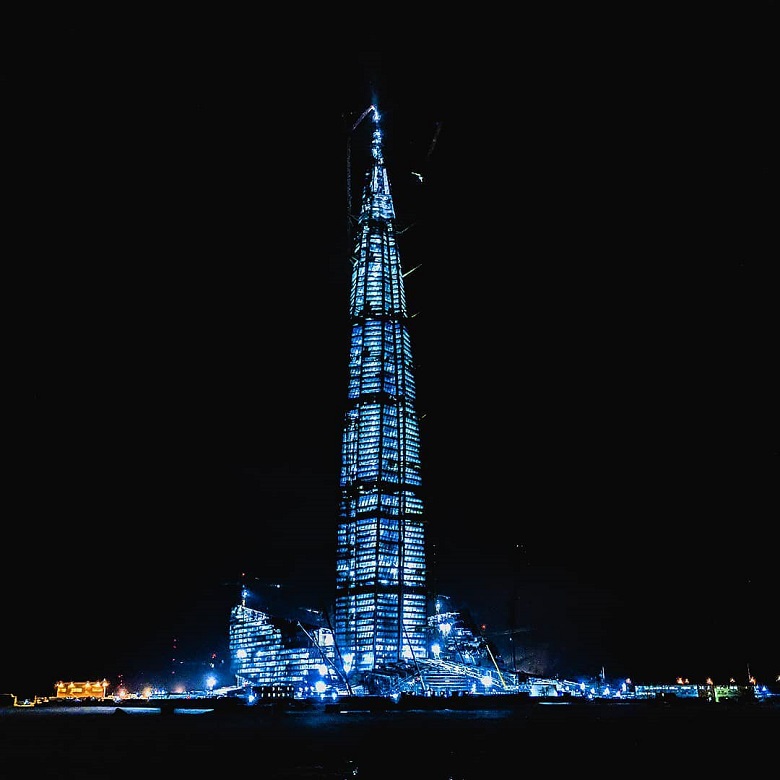
Photo source
Light from front lamps can go inside, unpredictably and uncomfortably illuminating offices and attacking the eyes of their inhabitants.
The key to the question of the interaction of internal and external light - in a very accurate calculation and balance.
What to do with the inner light going out
Daria Gerasimova:
According to the plan, the offices of light in the dark, but still working time, will highlight the tower from the inside, and the front lighting will align and compensate for this glow, playing the role of a light "veil". After the offices are closed, the lighting turns into an independent architectural object.

Illustration of the concept of architectural lighting Lakhta Center
What to do with the outside light going in
Uninvited illumination of office spaces with facade lights required individual solutions. The thin spot was the lamps installed in the frame of the double-glazed windows.
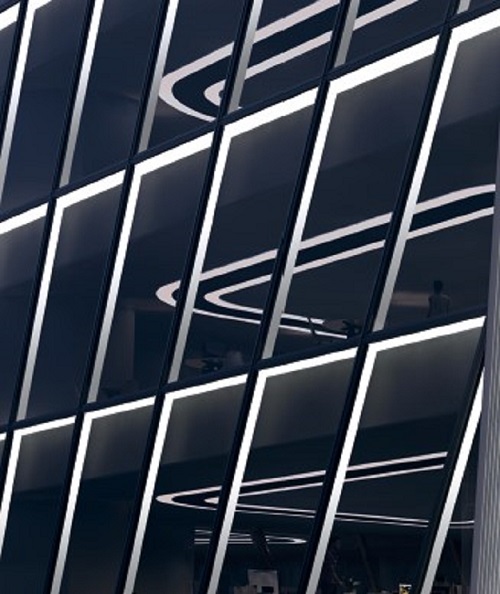
Fragment of the facade. Lamps are installed inside the glass. Illustration of the concept of architectural lighting Lakhta Center
One of the proposed options was to integrate the lamp in the lower corners of the facade frames.
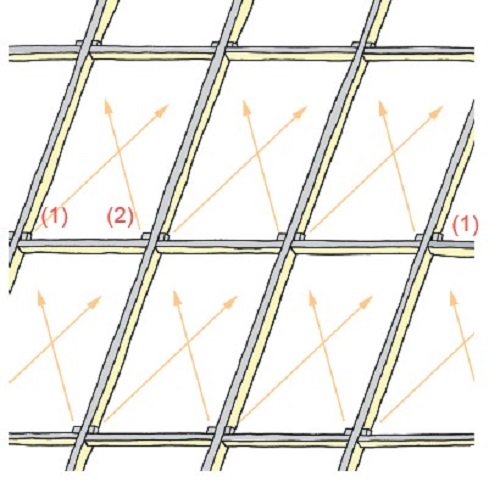
The location of the lamps and the direction of the light beam
From the pros - there are ready-made solutions, from the minuses - the light seeps into the office. The angular location "lights up" the side profile of the frames and gives uneven light bursts on their edges - up to 100 lux and even more.
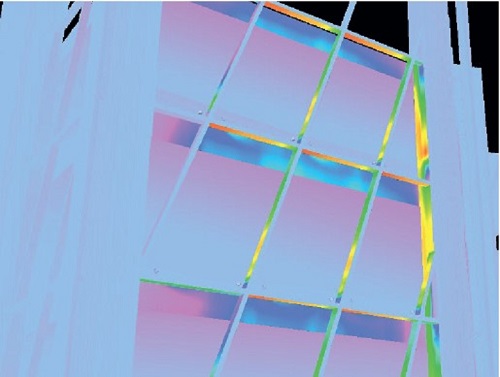
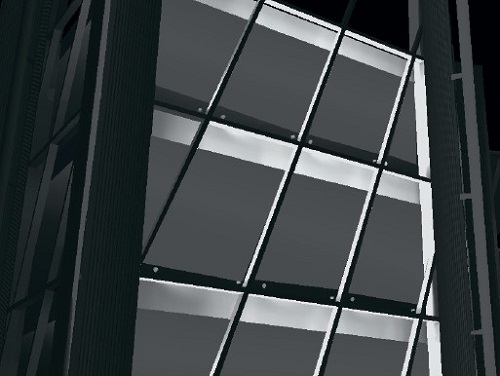
In this diagram, the illumination of the front frames with a light inside the room is clearly visible.
Daria Gerasimova:
Here are similar illustrations for a lamp with a central location:
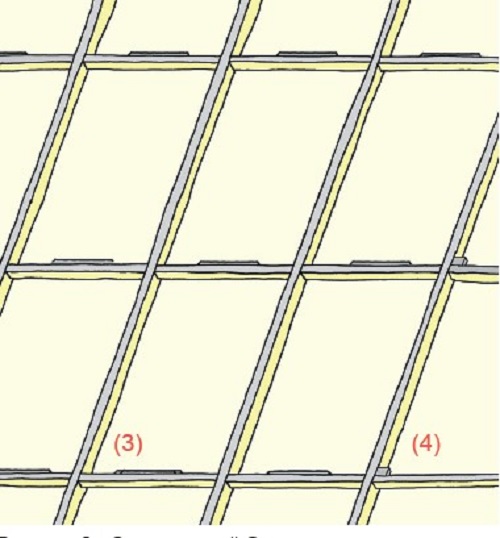
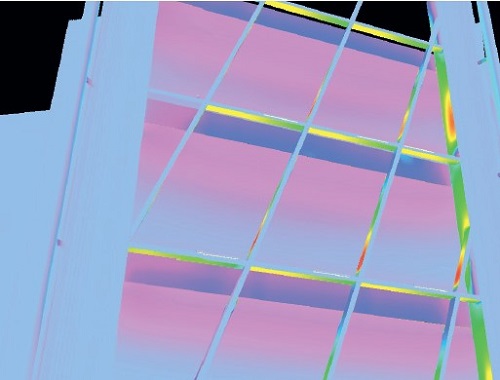
Smooth filling of front frames with diffused light, without active bursts
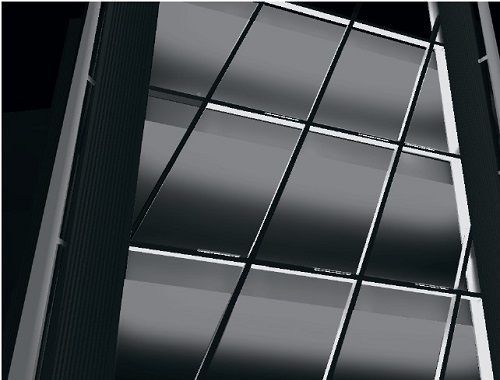
Ceiling light is minimal
The mentioned lamp in the center of the frame has a feature - a very narrow angle of beam, only 2 degrees. In practice, use 10-16 degrees, the lower threshold of typical products - 3 degrees. A narrow beam angle solves the problem of light falling into offices.
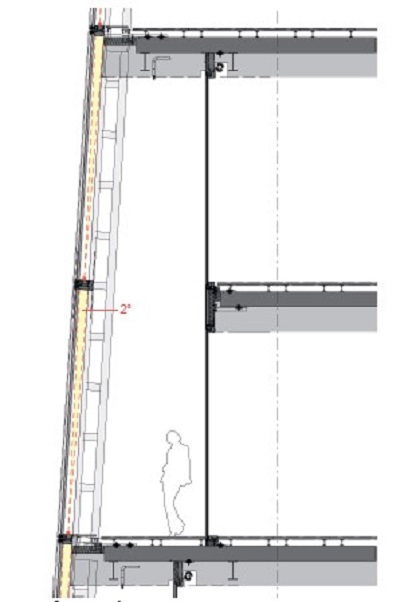
This is how the fixtures look at the installation site:
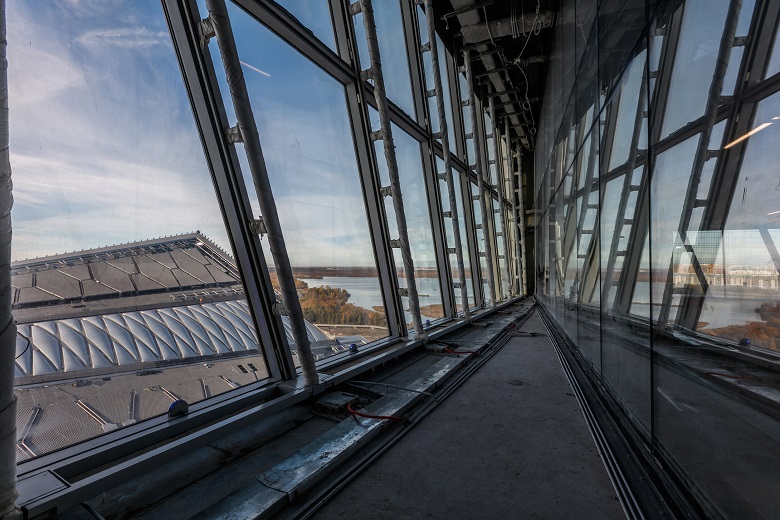
The direction of the beam is determined by the design of the device and the lens:
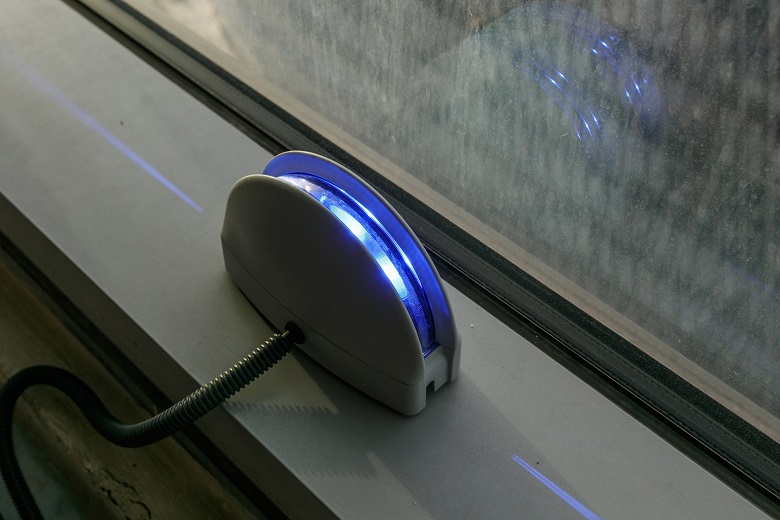
We will describe these and other lamps that make up the architectural lighting system of Lakhta Center, as well as the installation and control of light, in the next post. And we offer a break on a beautiful note - light scenarios.
The number of architectural lighting scenarios is theoretically unlimited - you can create at least for every day. So far, four basic options have been developed, not counting the minimalist duty mode.
Casual, basic
This option will be with us most of the year. It provides a gradient light fill of a neutral color. The tower is conventionally divided into longitudinal parts - those where there are double-glazed buffer zones and those where the facade thread is single.
The first ones are filled with brighter light at the top, with a smooth loss of intensity at the bottom. The second - on the contrary: a brighter glow below, as you move up the brightness loses its strength.

Sketch of the concept of architectural lighting Lakhta Center
Visualization:
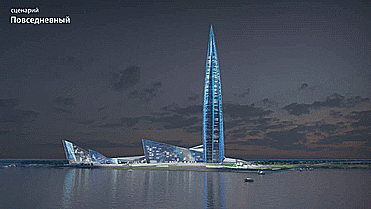
Casual, winter
Similar pattern of light intensity and gradient fill distribution, only the color changes to icy blue.

Festive
Almost all the holidays the tower will meet here in this sunshine - very relevant in our latitudes.
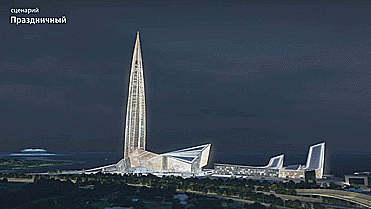
From the concept:
In addition to color, the backlight will please with dynamic effects - shimmer or soft play.
New Year
Of course, the Christmas tree! The first inclusion of Christmas tree lighting, many have already seen. It was still the most initial option - without the participation of all faces, all lamps and without adjustment. But even with this in mind, the “Christmas tree” has pleased many. About the Christmas debut - the first inclusion of the architectural lighting of the tower, we will tell more in the next part.

***
We thank for the help in the preparation of the material Yulia Gulyak - the head of the Design Office and Daria Gerasimova - the chief specialist-designer of the Design Office of Lakhta Center

They say that before it was building, and then - finishing work. People worked in three shifts, and at night it was like a beacon of light. And then the complex was inhabited by the inhabitants of the offices. Every day, who earlier, who later, they went home, one after another dimmed the light ... Lakhta Center gradually plunged into darkness, and it appeared - the Tower of Darkness ...
')

How do you like such a horror story? What really will happen to Lakhta Center at nightfall - read under the cut.
Brave new world: the kingdom of light
Light in darkness is the friend of all living things.

All creatures are drawn to him - from moths, driven only by instincts, to wandering travelers, rejoicing in salvation. In the dark sky, we are looking for stars, in a dark nook - the nearest lantern. We are warmed by the light in our own window, and we treat winter blues with festivals of lights in the open spaces from London to Moscow.

Festival of Light in Belgium. Photo source

And Prague ... Photo source

Winter Canyon in Vancouver. Photo source

And linden alley in Berlin
We turned night cities into a kingdom of light and no longer sleep at night - a man-made shine breaks a thousand-year rhythm. Life no longer has to stop with the advent of darkness. Night city is beautiful and sometimes unrecognizable.

Lomonosov Bridge over Fontanka, Petersburg
City buildings at dusk begin to transform. By midnight, some change shape, others - coloring, the third almost disappear, the fourth come into "movement." Not so long ago, the utilitarian night illumination today is turning into a light architecture, creating new spaces and a new quality of environment. These are the trends.

Sydney Opera. Photo source

Empire State Building and the panorama of the night in New York. Photo source
We couldn’t pass by this new shining reality, entrusting Lakhta Center's illumination to the moon, stars and earned office dwellers. Our designers got down to business. Let's see what they did?
Apparently invisible
The question of the visibility of the tower almost headed the agenda of the Lakhta Center in 2011. It seemed even less important how to build this uniquely complex object - it can be solved. But a heightened sense of visibility required a carefully weighted approach.

The architectural history begins with the visualization of remarkable panoramas taking into account the appearance of a new dominant on the Petersburg horizon.
Daria Gerasimova, Chief Specialist-Designer of the Design Office of Lakhta Center:
“We checked the visibility from different points of the city, inserting the Tower into the Three-dimensional model of urban space. [The Institute for Territorial Development, jointly with the Scientific and Research Center for the General Plan - note], took into account the curvature of the earth, the relief, green spaces, the atmosphere when the object is remote, chimneys, environmental reference points - outstanding buildings. The main points of view were highlighted - for example, they looked along the entire embankment from the Winter Palace, the General Staff, St. Isaac's Cathedral, the Smolny Cathedral. The result of using the model is an assessment of the perception of the space-spatial solution of the designed building in the context of the panoramas protected in accordance with the current legislation, and against the background of the surrounding building. When checking, we followed the main task - not to break the heavenly line of St. Petersburg and tactfully fit into the urban landscape ... "
As a result, the research has turned out such visualizations of panoramas:




Panoramas on the site of Lakhta Center
Of course, the tower can be found here - with its height it is strangely different. But somehow you can’t call the supertoll noticeably changing the panorama of the center - it is lost sight of due to the distance and features of the facade. Glass absorbs the colors of the sky and dissolves in the air, leaving only a hint and vague outlines - you need to know where to look. Today it is possible to compare visualization with the real picture.

Photo source

Photo source

Photo source


Photo source

Photo source
The distance, the facades and the weather do their job - the new and old city lives peacefully and practically isolated - the triumph of architectural segregation.
But it is afternoon. What happens at night? Darkness calls for antagonism. The meaning of the illumination is opposite to the daily tasks - we must not get lost in the darkness, stay on the horizon, get out of the dusk, become visible ...
The possibilities of Lakhta Center in this matter are measured in kilometers of LED strips, thousands of facade lights, 16 million light shades of the full color spectrum.

Testing backlight on the tower Lakhta Center. Photo by Victor Gusik
If you ignite in full - will be Las Vegas.

How light opportunities will be used is determined by the concept of architectural lighting. It was created jointly by engineers and designers of the Lakhta Center and specialists from Lichtvision Design & Engineering. To find out if light expansion is envisaged, take a look at the document.
Doctrine of light
In fact, the “team of light” was to build a second facade of the complex, layering the light envelope on top of constructive forms. Today, experts implement different ideas - they can completely change the night look of a building, from color to proportions. But in our case it was about recreating the day view of the Lakhta Center in the night reality.
North Arctic Tower
The basis of the architectural concept of the complex is images of water: waves, hummocks, cracked icebergs ... And all this is cold, local, referring to the shores of the Baltic, to the northernmost of the skyscraper coordinates.



Illustrations from the concept of architectural lighting Lakhta Center
From here, themed natural images turn into the concept of illumination: pure ice, illuminated by the sun, soft light flickering in the waves, cool blue, natural white. This outlines the color gamut, the intensity of the shades and the dynamic effects of the backlight.
Cool light hint
The daily temperature of illumination ranges from 3 to 4 thousand kelvins. It is a natural white color, soft and pleasant to the eye. This happens at sunrise, still gentle and cool.

Photo source
Warmer - a landscape with three thousand Kelvin, colder - the roof of the atrium with four. In the middle of the scale are the facades of the Multifunctional building and the tower: their luminescence heats up to 3, 5 thousand kelvins.
The intensity of the backlight is also regulated. The brightest light is provided for entrances, stairs, walkways, ramps - average values vary from 10 to 20 lux (lumens per m2). Here, the designers did not invent anything, taking the European and Russian norms as the basis. Those, in turn, appeal to the rational - a sense of security, adaptation, orientation and comfortable movement.

Illustration of the concept of architectural lighting Lakhta Center
The facades of the tower in everyday mode are illuminated at the level of the same 15-20 suites. Such intensity can be compared with the light of St. Petersburg twilight. 20 suites is about the intensity of natural light these days at the beginning of the ninth.

General view of the complex at night, taking into account the lighting intensity scheme. Illustration of the concept of architectural lighting.
Julia Gulyak, Head of the Design Office of Lakhta Center:
“It was not a task to fill everything with light, having spent a lot of money on it and continuing to spend it during operation. It was necessary to do everything discreetly, tactfully, with the use of diffused light, which is peculiar to St. Petersburg. ”

Not our option. Photo source
Descriptions of light restraint and subtle light hints are found throughout the text of the concept: “The goal is to create an elegant, sophisticated image, a memorable building, a symbol of grace, calm and restraint,” the designers fix the basics. And turn for this to an interesting reception.
Ice in a large pixel
The architectural appearance of the tower is formed by 15 faces, going upwards and meeting at one point.

Photo source
It is difficult to refrain from emphasizing precisely these dynamic lines with light. But the paths of least resistance usually lead the wrong way. Here and a sharp contour lighting led away from the desired restraint and subtle Petersburg flavor.
Julia Gulyak:
“Initially, we planned to illuminate the Lakhta Center’s tower by corner elements to emphasize the structure of this building. But the designer offered us to highlight not the corner elements, but directly the “petals” of the tower building. And - not direct light, but scattered. To do this, the lamps are built into the facade structures around the perimeter of the imposts, and when casting light we see a large “pixel”.

“Pixel” illumination of the facade of the tower - on the example of a fragment of New Year's illumination. Photo by Victor Gusik
Scattered light is applied to all objects of the complex, including landscape lamps. Bright ends, clear contours, contrasting combinations, play of light and shadow turned out to be forbidden - on the same faces it was replaced by a gradient. Good? Yes, not really.
I will ask without hints!
There is an organization in the city that requires the tower to be seen very clearly. Thin and delicate light hints sent by a skyscraper into the darkness of St. Petersburg are inappropriate for it. Because for the “Rosaviation” the designation of the boundaries of the object on the ground must be unambiguous.

Barrier lights on the WHSD cables. Photo source
Red barrage lights on high-rises, antennas, guys St. Petersburg bridges and guys stadium St. Petersburg you saw. This is an international light-marking system, exactly the same red lights, for example, on the hero of the week before last — the New York legend sold by the Chrysler Building.

Taking into account the height of the Lakhta Center tower, red beacons would have to be located almost throughout the whole volume. Knowing the designers, it is easy to imagine how they would worry about alien inclusions of lights of a non-complementary shade.

It is better for them not to show ...

During construction, the barrier light was standard - red and a bit intimidating. Photo source
Fortunately, according to the Guidelines for the Operation of Civilian Aerodromes of the Russian Federation (REGA RF-94), for buildings located outside the airfield, the fire can be not only red, but also blinking white. “The intensity of light in all directions should not be less than 10 cd, the frequency of flashes should be at least 60 per minute. The height should be 45 m. ”
Based on the found rate, we developed a variant of the barrier lighting for the tower. Now every 45 meters she has - white LED lights, ten per floor, plus a beacon on the steeple. And the “Rosaviation” is good, and it fits perfectly into the overall concept of the backlight.


Layout of barrier lights on the tower. Illustration of the concept of architectural lighting Lakhta Center

White barrage lights on the tower spire. Photo source

Lighthouse on the steeple. Photo source

Barriers include not only at night, but also at any time of the day while reducing visibility. Photo source
The “white” fence is innovative - the project was separately coordinated with the regulatory authorities.
And voluntarily passed another agreement - from the unusual.
In the autumn put out the light
If the words “bird rights” cause you some confusion, it means that you are definitely not a resident of Canada or, for example, America. Perhaps we have few skyscrapers, a lot of birds, and there is still something to work in the legal field on other issues, but the experience of Lakhta Center in the field of protection of birds can be considered unique for domestic practice.

Photo by Victor Gusik
We have already told how ornithologists conducted bird watching in Lahta. For the concept of architectural lighting, scientists also gave their recommendations. The greatest curtsy in the direction of the birds is a change in the lighting regime during the period of seasonal migrations. Since the birds fly at night, in the fall and spring from 2 at night and until 9 in the morning the lighting will be minimal so as not to attract flocks to the light trap. Perhaps this is the only moment that could cause mutual misunderstanding and lead to unpleasant accidents.

The most minimalistic - backlight mode. Barrage lights for aircraft and light on the front faces of the facade are involved.
By the way - in the States ornithologists are statistics of air incidents involving birds. According to the relevant federal agency US Fish & Wildlife service, less than 1% of birds die from collisions with skyscrapers, about 56% of the incident occur to low-rise buildings, and about 44% in general in rural areas. This is consistent with the data of our ornithologists - they also noted that the main stream of birds goes at elevations up to 100 meters.

Photo by Ivan Smelov
Also in the reports they dispel the main myth - that the birds do not distinguish glass as a barrier. Glass birds see as a barrier to distinguish, from the collisions go. So the most difficult issue with a glass facade is another.
Light and glass
Placing a lamp on a brick wall is not difficult.

Photo source
On a transparent glass facade - it is quite another thing, even while omitting the technical difficulties of fasteners. The light from the tower penetrates the outside - as we saw it during construction work and see at the current stage of finishing.

Photo source
Light from front lamps can go inside, unpredictably and uncomfortably illuminating offices and attacking the eyes of their inhabitants.
The key to the question of the interaction of internal and external light - in a very accurate calculation and balance.
What to do with the inner light going out
Daria Gerasimova:
“Mostly at night we will have offices lit up (emergency light).” There is also a risk of influencing the appearance of the building of bright spots of luminous multi-level spaces. To prevent this from happening, we designed an architectural light that should compensate for all this and unite the facade. ”
According to the plan, the offices of light in the dark, but still working time, will highlight the tower from the inside, and the front lighting will align and compensate for this glow, playing the role of a light "veil". After the offices are closed, the lighting turns into an independent architectural object.

Illustration of the concept of architectural lighting Lakhta Center
What to do with the outside light going in
Uninvited illumination of office spaces with facade lights required individual solutions. The thin spot was the lamps installed in the frame of the double-glazed windows.

Fragment of the facade. Lamps are installed inside the glass. Illustration of the concept of architectural lighting Lakhta Center
One of the proposed options was to integrate the lamp in the lower corners of the facade frames.

The location of the lamps and the direction of the light beam
From the pros - there are ready-made solutions, from the minuses - the light seeps into the office. The angular location "lights up" the side profile of the frames and gives uneven light bursts on their edges - up to 100 lux and even more.


In this diagram, the illumination of the front frames with a light inside the room is clearly visible.
Daria Gerasimova:
"As a result, we decided to choose one luminaire in the center of the frame with a narrow lens, which allows you to control the propagation of the luminous flux, and eliminates negative visual influence from the propagation of light inside the office space - this is important, because we are very careful about comfort not only outside, but and inside the building, to ensure that the office class A + "
Here are similar illustrations for a lamp with a central location:


Smooth filling of front frames with diffused light, without active bursts

Ceiling light is minimal
The mentioned lamp in the center of the frame has a feature - a very narrow angle of beam, only 2 degrees. In practice, use 10-16 degrees, the lower threshold of typical products - 3 degrees. A narrow beam angle solves the problem of light falling into offices.

This is how the fixtures look at the installation site:

The direction of the beam is determined by the design of the device and the lens:

We will describe these and other lamps that make up the architectural lighting system of Lakhta Center, as well as the installation and control of light, in the next post. And we offer a break on a beautiful note - light scenarios.
Light tower
The number of architectural lighting scenarios is theoretically unlimited - you can create at least for every day. So far, four basic options have been developed, not counting the minimalist duty mode.
Casual, basic
This option will be with us most of the year. It provides a gradient light fill of a neutral color. The tower is conventionally divided into longitudinal parts - those where there are double-glazed buffer zones and those where the facade thread is single.
The first ones are filled with brighter light at the top, with a smooth loss of intensity at the bottom. The second - on the contrary: a brighter glow below, as you move up the brightness loses its strength.

Sketch of the concept of architectural lighting Lakhta Center
Visualization:

Casual, winter
Similar pattern of light intensity and gradient fill distribution, only the color changes to icy blue.

Festive
Almost all the holidays the tower will meet here in this sunshine - very relevant in our latitudes.

From the concept:
“Festive mode is an ice structure, illuminated by sunlight. Soft transitions of warm tones create a feeling of pure ice with a golden effect of sunlight. ”
In addition to color, the backlight will please with dynamic effects - shimmer or soft play.
New Year
Of course, the Christmas tree! The first inclusion of Christmas tree lighting, many have already seen. It was still the most initial option - without the participation of all faces, all lamps and without adjustment. But even with this in mind, the “Christmas tree” has pleased many. About the Christmas debut - the first inclusion of the architectural lighting of the tower, we will tell more in the next part.

***
We thank for the help in the preparation of the material Yulia Gulyak - the head of the Design Office and Daria Gerasimova - the chief specialist-designer of the Design Office of Lakhta Center
Source: https://habr.com/ru/post/444062/
All Articles